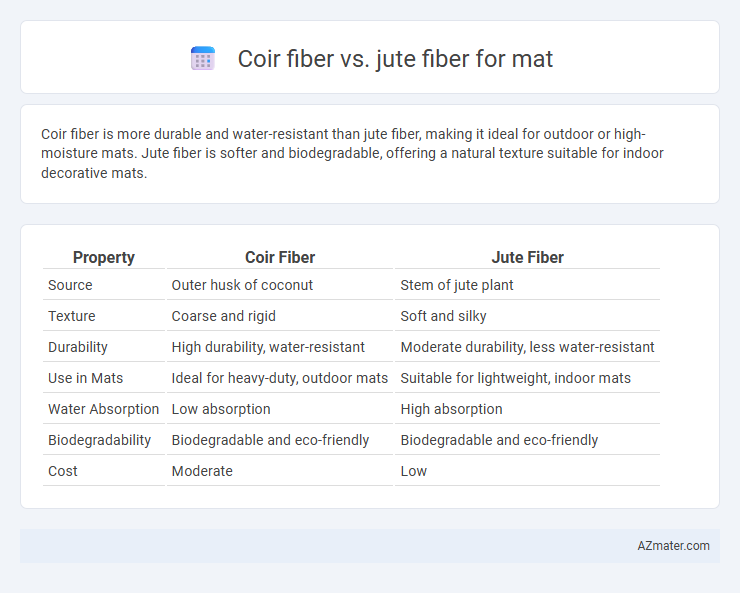Coir fiber is more durable and water-resistant than jute fiber, making it ideal for outdoor or high-moisture mats. Jute fiber is softer and biodegradable, offering a natural texture suitable for indoor decorative mats.
Table of Comparison
| Property | Coir Fiber | Jute Fiber |
|---|---|---|
| Source | Outer husk of coconut | Stem of jute plant |
| Texture | Coarse and rigid | Soft and silky |
| Durability | High durability, water-resistant | Moderate durability, less water-resistant |
| Use in Mats | Ideal for heavy-duty, outdoor mats | Suitable for lightweight, indoor mats |
| Water Absorption | Low absorption | High absorption |
| Biodegradability | Biodegradable and eco-friendly | Biodegradable and eco-friendly |
| Cost | Moderate | Low |
Introduction to Coir Fiber and Jute Fiber
Coir fiber, derived from the outer husk of coconuts, is renowned for its durability, water resistance, and coarse texture, making it ideal for mats used in both indoor and outdoor environments. Jute fiber, sourced from the stem of the jute plant, is valued for its softness, biodegradability, and natural golden color, which provides a more delicate and eco-friendly option for mat production. Both fibers offer sustainable solutions, with coir focusing on strength and moisture resistance, while jute emphasizes comfort and environmental benefits.
Origin and Production Process
Coir fiber, obtained from the husk of coconut fruits primarily grown in India and Sri Lanka, undergoes a labor-intensive extraction process involving retting, decortication, and drying to produce coarse and durable fibers. Jute fiber originates from the stalks of the Corchorus plant, cultivated mainly in Bangladesh and India, and is extracted through water retting followed by stripping and washing to yield soft, fine, and shiny fibers. The distinct production methods directly influence the texture and strength of coir and jute mats, making coir ideal for heavy-duty outdoor use and jute preferred for lightweight, biodegradable applications.
Physical and Mechanical Properties
Coir fiber exhibits higher durability and abrasion resistance compared to jute fiber, making it ideal for heavy-duty mats that require long-lasting physical strength. Coir's coarse texture and greater tensile strength enhance its mechanical resilience, while jute fiber offers better flexibility and a softer feel but lower impact resistance. The high lignin content in coir contributes to its water resistance and dimensional stability, whereas jute fibers are more prone to moisture absorption and degradation over time.
Durability and Longevity Comparison
Coir fiber exhibits superior durability and water resistance compared to jute fiber, making coir mats ideal for heavy-duty outdoor use. Jute fiber, although softer and more biodegradable, tends to degrade faster when exposed to moisture and UV light, resulting in shorter mat longevity. Coir's high lignin content and coarse texture enhance mat resilience, providing a longer lifespan under harsh environmental conditions.
Comfort and Texture for Mats
Coir fiber offers a coarse and rough texture, providing firm support ideal for outdoor mats that require durability but less softness. Jute fiber features a softer, more pliable texture, enhancing comfort underfoot, making it suitable for indoor mats where a gentle touch is preferred. The choice between coir and jute fibers depends on the balance between rugged durability and tactile comfort required for specific mat applications.
Eco-Friendliness and Sustainability
Coir fiber, derived from coconut husks, is highly biodegradable and resists moisture, making it an eco-friendly choice for mats that require durability and water resistance. Jute fiber, obtained from the jute plant, offers excellent biodegradability and a lower carbon footprint due to its rapid growth cycle and minimal pesticide usage, enhancing its sustainability for environmentally conscious mat production. Both fibers support sustainable agriculture, but jute's faster renewability contrasts with coir's superior lifespan in high-humidity environments.
Cost and Market Availability
Coir fiber mats generally have higher durability but come at a slightly higher cost compared to jute fiber mats, making coir a preferred choice for long-lasting, weather-resistant products. Jute fiber mats are more affordable and widely available in markets, especially in regions like India and Bangladesh, where jute cultivation is extensive. The market availability of jute fibers ensures a steady supply chain, while coir fibers, sourced mainly from coconut husks, depend on coastal production zones, influencing regional cost variations.
Aesthetic Appeal and Design Versatility
Coir fiber offers a coarse texture and natural brown hues that create a rustic, earthy aesthetic ideal for traditional and outdoor mats. Jute fiber provides a finer, softer weave with a creamy to golden color palette, enabling intricate patterns and a more refined look suitable for indoor and decorative mats. The design versatility of jute surpasses coir due to its pliability and ability to absorb dyes, allowing a broader range of aesthetic options.
Maintenance and Care Requirements
Coir fiber mats demand minimal maintenance due to their natural resistance to moisture, stains, and microbial growth, requiring only regular shaking or vacuuming to keep them clean. Jute fiber mats need more careful handling; they are susceptible to moisture damage and mold, necessitating gentle cleaning and thorough drying after exposure to water. Both fibers benefit from avoiding prolonged wet conditions, but coir's durability makes it more practical for high-traffic or outdoor mat applications.
Best Applications: Coir vs Jute Mats
Coir fiber mats excel in outdoor applications due to their high durability, water resistance, and natural abrasion resistance, making them ideal for doormats, outdoor rugs, and erosion control products. Jute fiber mats prioritize indoor use with their softer texture, excellent moisture absorption, and biodegradability, rendering them suitable for decorative mats, area rugs, and eco-friendly interior flooring solutions. The choice between coir and jute mats depends on the specific application requirements such as exposure to moisture, wear resistance, and desired aesthetic qualities.

Infographic: Coir fiber vs Jute fiber for Mat
 azmater.com
azmater.com